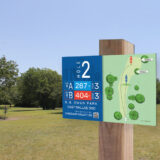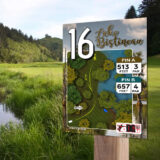Tee signs in disc golf aren’t just markers; they’re the initial guides that pave the way for an exhilarating round. Crafting an effective tee sign involves a blend of essential elements that go beyond mere information provision. Let’s uncover the best practices that transform ordinary tee signs into indispensable course companions, enhancing the player experience and guiding them through the intricacies of each hole.
Visibility Is Key:
The first rule of an effective tee sign is visibility. Ensure that the sign is easily spotted from the tee pad, even at a distance. Opt for clear and bold fonts with high contrast against the background to guarantee readability in various lighting conditions.
Durability Against Elements:
Tee signs endure the brunt of outdoor elements. Select materials known for their durability, capable of withstanding rain, sun, wind, and other environmental factors. Metal, high-grade plastics, or weather-resistant composites often serve well in maintaining longevity.
Weather Resistance for Longevity:
Shielding the vital information from weather-induced wear is imperative. Laminated graphics, protective coatings, or weatherproof materials safeguard the signs against fading, warping, or damage caused by prolonged exposure to the elements.
Information Clarity and Conciseness:
Clarity reigns supreme. Ensure that the information presented on tee signs is clear, concise, and relevant. Include hole number, distance to the basket, par, and any notable obstacles or hazards. Avoid cluttering the sign with excessive details that might overwhelm or confuse players.
User-Friendly Design:
A well-designed tee sign is intuitive. Organize information in a logical sequence that aids players in swiftly interpreting the hole layout. Utilize graphics, arrows, or icons to illustrate fairways, basket placements, and the intended flight path, aiding players in making informed shot decisions.
Maintenance and Upkeep:
Regular maintenance is crucial for preserving tee signs. Periodic inspections, cleaning, and repairs ensure that the signs remain in top-notch condition. Establishing a maintenance schedule helps in addressing any wear or damage promptly.
Engaging and Informative:
Enhance the player experience by making tee signs engaging and informative. Consider incorporating interesting facts about the course, historical anecdotes, or local flora and fauna. Engaging content fosters a deeper connection between players and the course.
Community Involvement:
Involve the disc golf community in the tee sign creation process. Seek feedback from players to understand their preferences and requirements. Collaborating with local artists or enthusiasts can infuse creativity and a sense of community ownership into the signs.
Mastering tee sign excellence involves a careful blend of functionality, durability, and user engagement. By adhering to these best practices, disc golf courses can elevate the tee sign experience, guiding players through an immersive and enjoyable round.
Tee signs aren’t just markers; they’re storytellers that unveil the narrative of each hole, setting the stage for thrilling disc golf adventures.









